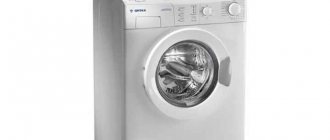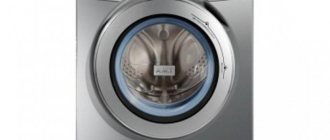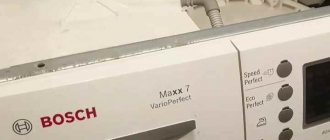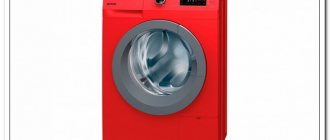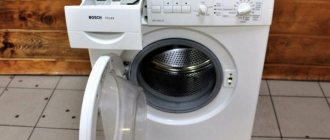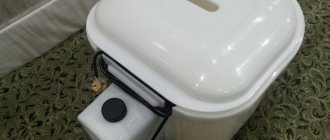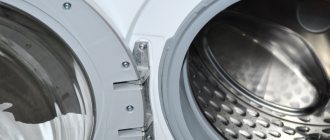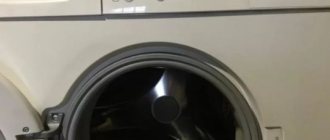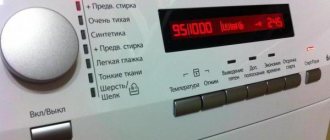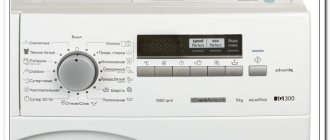The history of the creation of the Vyatka washing machine.
The history of the creation of an automatic washing machine begins in 1980. Many people mistakenly consider it the first automatic car, but this is not so. Vyatka was not the first automatic washing machine. Shortly before its first copy, another automatic device of the Volga-10 brand was produced. However, it was quickly removed from the production line due to its excessive power. The power supply systems could not handle such a large electrical current draw and the fuse tripped.
History of the Vyatka brand
During the Soviet era, only the wives of party officials and diplomats could boast of foreign washing machines. Everything changed in the late 70s, when the first Vyatka-automatic washing machine, a twin sister of the Italian Ariston model, rolled off the assembly line at a plant in the city of Kirov. At that time, all the neighbors in the house came to see such a miracle of technology.
Vertical Vyatka
In the 80th year of the last century, working under the license of Merloni Progetti, he released a trial model “Vyatka-automatic 12”. From the name it is clear that the washing machine had 12 automatic operating modes. At the end of February 1981, the first batch of these models was released in the amount of 100 pieces.
The cost of these devices was not small, it was 495 rubles. Therefore, not everyone could afford such luxury. Over time, the price dropped slightly to 400.
In connection with the advent of the “Vyatka-automatic”, Soviet society became acquainted with another innovation. It was advertised on TV. Advertising for this product was one of the first on television.
Not everyone could buy a domestically produced washing machine, although it was freely sold in stores. In addition to the cost, a certificate from the housing office was also required stating that the electrical wiring at the place of future operation can withstand the corresponding load.
Vyatki were assembled under the license of Marloni Progetti, using Italian equipment for many years. In 2005, due to bankruptcy, the company was bought by the Italian brand Candy. In this regard, production was modernized, and the model range was replenished with modern technical devices with an appropriate set of characteristics.
Do you store laundry in the washing machine?
Oh yes! No.
General information
The first samples of the machine had 12 washing programs. At this time, for the majority of the population, such technologies were new. Everyone dreamed of getting this unit, but it was very difficult. Firstly, the cost of the machine was high.
The first batches were sold around five hundred rubles, later the price was reduced to four hundred. Also, not all houses were suitable for operating this washing machine, because the wiring in houses built before 1978 was not suitable for such a large electrical current consumption.
In the 90s, due to the difficult economic situation, Vyatka production was almost closed. Foreign investors breathed life into it. And today the plant produces about three hundred thousand cars annually. These machines are also now exported to countries in Europe.
Features of washing machines
The Vyatka brand produces budget models of washing machines with an average price of about 8,000 rubles. But in terms of characteristics and quality, they can compete with devices from more well-known brands.
Vyatka-automatic washing machines are spacious and economical in terms of energy consumption. The spin speed of the drum is up to 1000. Modern models have sufficient functionality with the ability to select programs.
Expert opinion
I work in the household appliance repair industry. Extensive experience in restoring washing machines and dishwashers.
Ask a Question
Vyatka washing machines are assembled from foreign-made components. They stand out for their modern design and various sizes. The model range includes full-size and narrow machines. Therefore, buyers have plenty to choose from.
The technical capabilities of Vyatka are in no way inferior to more expensive imported analogues. They contain all the functions necessary for convenient use. The machines have a half-load capability and include additional washing options. They are simple and easy to operate; you can select temperature modes and set the spin speed.
All equipment produced at the plant is manufactured in accordance with GOST standards.
Do you turn off the water tap after washing?
Oh yes! No.
Advantages and disadvantages
Equipment manufacturers take into account the demand for certain capabilities and characteristics of devices. The following models are especially popular on the Russian market:
- with a frontal method of loading things;
- having shallow depth and compact dimensions;
- economical modifications in terms of water and electricity consumption.
It is worth noting that, unlike Europeans, domestic users prefer versions with front-loading laundry. Therefore, among Russian-made washing machines, only the representative office produces units with vertical filling of the working compartment.
Among the non-standard modifications, the following features can be noted:
- reduced depth from 500 to 550 millimeters;
- narrow versions with volume from 390 to 470 mm;
- full-size options in European dimensions;
- super-narrow models with a depth of 330 to 360 mm.
Consumer Reviews
Bought for a summer house. She justified herself. It washes not only outer clothing for working in the garden, but also everything else that needs to be washed. At the same time, despite the simplicity of the design, it washes well. There is almost no load on the weak dacha electrical network. It requires almost no attention to itself. We are glad.
Mini Vyatka SM 2Maxim
This car (or rather the money to buy it) was given to us as a wedding gift. The car was purchased in August 2002. During operation, no serious problems were identified. The screw securing the drum pulley to its axis was unscrewed twice. As a result, the drum stopped spinning. I fixed the problem myself using a wrench by removing the back wall. The first time, apparently, it didn’t last, because a few months later it came loose again. I tightened it a second time with all my heart, and it won’t come off anymore. The main drawback, in my opinion, is the frankly lousy preparation of the metal surface of the body for painting. The enamel began to peel off after about three years. I had to tint it with pre-treatment with a rust converter. Now it’s working somewhere else. In general, the unit is simple and reliable. It works and washes very well. I don’t know how long it will work, but we will only replace it if there is a critical breakdown.
Vyatka Katyusha 522 PEvgeniy
The car was purchased in 2001 (in February, I think). During all this time there was only one problem, which can hardly be called a breakdown - last year the dirty water drain became clogged. I had to take it apart and clean it by hand. All this took about an hour and a half (including the time spent studying the drainage device itself). After that the car worked like new again! Now it’s the end of May 2022 and everything is still great! If they were still selling it in stores, I would definitely recommend it.
Vyatka Maria 1022 PAndrey
Previous
Next
Criterias of choice
Narrow-sized Russian-made washing machines lose their advantage in maximum load capacity, but gain in terms of efficiency. For example, a Kandy brand unit with a depth of 330 millimeters can accommodate 4.5 kilograms of laundry, and a volume of 400 mm processes up to seven kilograms. Standard domestic devices are designed for a load of 8 kg.
When choosing a unit, you should take into account the degree of protection against leaks and voltage surges. Most modern models have efficiency class “A”, which meets European requirements. The average water consumption does not exceed 45 liters per cycle thanks to the use of the latest technologies, including commutator motors for a Russian-made washing machine.
Unfortunately, the assembly and production of equipment on the territory of the Russian Federation did not have a positive effect on the quality of the assembly. But the price has also decreased, which has made the devices more accessible to the wider population. As service center specialists note, Chinese and Russian modifications can be classified as the most unreliable devices in their segment.
Competitors
There is enormous competition in this market. Among the most popular analogues, the following modifications can be noted:
- Miele. These devices are assembled only in Germany, all elements undergo several stages of testing, and the warranty period is 30 years. Features: absence of vibration during spin mode, presence of a “honeycomb” drum in which the laundry slides over a certain water film.
- Electrolux. Swedish technology is considered one of the most reliable in the world. High-tech models from this manufacturer are equipped with voice control and a large-scale electronic remote control.
- The American company Whirlpool is promoting the latest technologies (“sixth sense MAX”) on the market, aimed at independently weighing the items being serviced, as well as counting the required operating cycle time.
- Zanussi is Italian equipment, distinguished by a wide range and original exterior. Experts and consumers include high build quality and easier loading of laundry thanks to the inclined drum.
- ASKO is a Scandinavian brand with particular demands on product quality. The company pays great attention to testing and several stages of control. The main advantage is the safety of the materials used and our own production technology.
Problems with the engine variable speed pulley
Sometimes repairing a Vyatka washing machine can be difficult when searching for components. Since the units were produced a long time ago, it can be difficult to find the parts needed to replace them. However, you can pick up spare parts from more modern machines that are suitable for old washing machines.
If we talk about typical problems, the variable speed pulley of the engine often breaks in Vyatka-automatic cars. With such a malfunction, the “centrifuge” cannot gain speed during the spin cycle, and the washing machine makes a lot of noise during operation. The main wash runs normally.
This damage is due to natural wear and tear. The retaining ring slips off the pulley shaft, and the fasteners of the plastic coupling are destroyed. For this reason, the normal operation of the engine is disrupted.
To repair a Vyatka-automatic machine with your own hands, in this case you will need a puller, a hacksaw and a chisel. It is not possible to simply remove the variator pulley from the shaft; it will have to be destroyed using tools.
The variator pulley must be removed very carefully so as not to damage the shaft and motor itself.
Purchasing the right spare part specifically for the Vyatka model can be problematic. If the original part is not available, it can be replaced with a regular pulley, the outer and inner diameters of which are 28 and 16.5 mm, respectively. A similar element is found in Candy AQUAMATIC8T 31081680 machines.
More about manufacturers
Below are several models of units with brief characteristics:
- “Vyatka-Maria”, an automatic device with dimensions of 850/600/540 mm with a load of up to 5 kg.
- “Vyatka-Katyusha” is an analogue with a working volume of 450 mm and a capacity of 4 kg. Both versions are equipped with a stainless steel tank, the cost starts from 11 thousand rubles.
- Indesit IWUB 4085 is a “washing machine” with a depth of only 330 mm. Such dimensions allow it to be used in small spaces. Maximum load – 4 kg, spin – 800 rpm, class “D”. Partial protection against leakage is provided, the price is 15 thousand rubles.
- The review of models of Russian washing machines continues with the Bosch WLG 24260 OE automatic machine with a front-loading type (5 kg). The depth of the unit is 400 mm, the maximum number of revolutions per minute is 1200. It is noteworthy that this device has an “Aquaspar 3D” system, which ensures uniform humidification of things with minimal water consumption. Other advantages include a functional electronic monitor, price – from 23 thousand rubles.
- "Ariston" Hotpoint VMUF 501-B is a narrow modification with a load of up to five kilograms of laundry and a spin power of no more than one thousand revolutions. There is an “anti-allergy” option, the cost is about 18 thousand rubles.
- “Ocean” WFO-860S3 is a domestic version with a vertical type of laundry loading and electronic control. There is a display for monitoring the water level, a compartment for conditioner and bleach. Additional loading of items is possible after turning on the device. Overall dimensions – 910/520/530 mm, suitable for installation in small and narrow spaces.
The drum does not turn well
Another typical problem with Vyatka machines is that the drum rotates with difficulty. The problem is especially noticeable when the appliance performs the “Wash” and “Rinse” modes. This “symptom” can occur for several reasons.
- The drive belt has stretched. To confirm or refute your guess, you will have to remove the rear (for front-facing) or side (for vertical) panel of the case and check the rubber band. To tighten the strap, you need to move the motor down. This is easy to do - loosen the right nut and rotate the engine around the left bolts with which it is attached to the tank. When finished, the nut should be tightened back.
- The motor capacitor has lost power. The element is located inside the housing. To fix the washer, the capacitor will have to be replaced.
- Motor malfunction. The main “symptom” of problems with the motor is the burning smell emanating from a working washing machine. Typically, problems with the engine occur when water gets on it. Therefore, carefully inspect the walls of the tank for cracks.
If the tank is really leaking, you should think about the advisability of repairing the Vyatka washing machine.
Both the tank and the motor will have to be replaced. In this case, it is better to overpay a little and buy a new, modern machine, rather than spend the same money on purchasing components for an old “home assistant”.
What should you pay attention to?
When buying a device assembled in the Russian Federation, focus on the following points:
- Protection. Choose a modification that is completely protected from leaks (body and hoses). Why do you need extra problems? Be sure to check these details.
- Energy consumption class. Like European analogues, the energy consumption class is A.
- Water consumption. Average - 45 l. Savings are achieved through Inverter Direct Drive and Smart Technology innovations.
- The quality of your water. There is no special protection against low-quality water - only a basic mechanical filter installed at the inlet. Scale formation is reduced using special means. Please note - Hi-tech Beko heating element reduces scale deposits by 40%.
Protection against voltage surges. There must be a surge protector. Similar filters are found in Beko machines. "Atlantas" can operate in a wide range - 170–255 V. Vestel provides a shutdown when a voltage surge exceeds 260 V. Then the equipment turns on automatically.
DIY repair
You can try to repair common problems yourself by following the instructions below.
The drum does not rotate
If the washing machine motor cannot rotate the tank loaded with laundry at the required speed, or it does not rotate at all, first of all you need to understand the cause of the breakdown.
When the washer's built-in self-diagnosis does not work, first check the drive belt. Even if it does not jump off, but slides along the motor pulley, the drum cannot rotate normally and gain the necessary speed for washing.
The reason may not be in the belt itself, but in the pulley - a system of a pair of rings with a rim connected by stiffeners (spokes). The pulley could be damaged during operation, or initially have a manufacturing defect. In this case, it must be replaced.
To do this, follow the instructions below:
- Remove the back panel.
- Pull the drive belt off the pulley and check for damage.
- Inspect the pulley itself. If there are defects and you want to change it yourself, proceed step by step.
- Remove any interfering wires from the motor and unscrew it completely.
- Find the tools: a mechanical bearing puller for dismantling and a hand-held blowtorch.
- Organize a place for repairs in the garage, in the yard, in a workshop or on the street (it is not recommended to perform such manipulations in an apartment).
- Attach the bearing puller to the pulley and apply tension with it.
- Heat the pulley with a heated soldering iron (try not to touch adjacent parts)
- When the pulley heats up properly, it will quickly come off on its own.
- Buy a similar pulley at a parts store or order online.
- Heat the purchased pulley red hot with a blowtorch.
- Install the pulley, wait until it cools down, and return the removed engine to its place.
- If the drive belt is damaged or already worn out, do not forget to change it too.
- Secure the back wall.
- Connect the machine to the network and test it in idle mode.
